Some of the links in this article are affiliate links which means that if you choose to click on them and make a purchase, I earn a small commission at no extra cost to you.
Also, as an Amazon Associate, I earn from qualifying Amazon purchases.
For more details, please read the full disclosure here.
Thanks so much for your support!
Let’s have fun with another color experiment. This time, we’re going to look at how to make the color purple.
You’re probably thinking, don’t you just mix blue and red? And, generally speaking, you’d be right. That said, there’s quite a bit more to making a purple paint color than most people expect.
Let’s dive into some experimenting with different blues and reds and maybe we’ll throw in a few other colors.
You’ll be able to follow this process step by step through photos and detailed explanations. I’ll also include all of the recipes that I use so you can take the ones you want and add them to your own color-mixing recipe book. Let’s get started!
In This Article...
- Paint Colors You Can Use To Make Purple
- What Two Acrylic Paint Colors Make Purple?
- How To Mute The Color Purple So It’s Less Vibrant
- How To Make The Color Purple Lighter
- How To Mix The Perfect Lavender Acrylic Paint Color
- Can You Make Purple Acrylic Paint Even Darker?
- Mixing Up A Royal Purple Color
- How To Make An Icy Cool Purple Color
- Making A Warm Color Purple
- How To Make The Color Purple Using…Brown???
- Even More Acrylic Paint Recipes For Making The Color Purple!
- How To Use Purple In Your Artwork
- Final Thoughts On Experimenting With Making Purple Paint
Paint Colors You Can Use To Make Purple
Below, you’ll find a list of all paint colors used for each purple color experiment and any other mixture mentioned. Don’t worry, I go into detail with recipes and paints used for all of the experiments. I also throw in a few bonus paint mixes that will give you purple so you’ll definitely want to stick around for that!
In addition, I’ve dropped a ton of links where you can check prices and availability, in case you see something you just can’t live without. That said, some of the Arteza paint colors listed came in a set of 60 so I didn’t want to link it to each individual paint color. If you do see a color that you want, I highly recommend the Arteza Premium Set of 60. It’s got metallics and even a neon pink that’ll make you go “wowza”.
So, if you’ve been researching how to make the color purple, look no further, my friend!
Master List of Paint Colors Used In Experiments:
- Cadmium Red Medium (Liquitex Basics)
- Alizarin Crimson (Liquitex Professional Heavy Body)
- Cadmium Red Deep (Liquitex Basics)
- Rose Madder (Arteza Premium)
- Quinacridone Magenta (Liquitex Basics)
- Magenta Light (Arteza Premium)
- Rose Azo (Pebeo)
- Cadmium Orange (Liquitex Basics)
- Yellow Oxide (Liquitex Basics)
- Cadmium Yellow Medium (Liquitex Basics)
- Naples Yellow (Arteza Premium)
- Phthalo Green (Liquitex Basics)
- Light Green Permanent (Liquitex Basics)
- Hooker’s Green (Liquitex Basics)
- Light Sap Green (Arteza Premium)
- Chromium Oxide Green (Arteza Premium)
- Cerulean Blue (Liquitex Basics)
- Ultramarine Blue (Liquitex Basics)
- Phthalo Blue (Liquitex Basics)
- Primary Blue (Liquitex Basics)
- Cobalt Blue (Liquitex Basics)
- Diox Purple (Liquitex Basics)
- Violet (Arteza Premium)
- Titanium White (Liquitex Basics)
- Zinc White (Golden Professional Heavy Body)
- Unbleached Titanium (Liquitex Basics)
- Burnt Umber (Liquitex Basics)
- Raw Umber (Liquitex Basics)
- Burnt Sienna (Golden Professional Heavy Body)
- Mars Black (Liquitex Basics)
Experiment Disclosure: Please keep in mind that lighting, screen settings, and even using different brands of acrylic paint can alter the color seen so your results may vary from mine.
Also, a “part” can be any amount of paint. The most important thing is to make sure all “parts” are roughly the same amount/size.
What Two Acrylic Paint Colors Make Purple?
First of all, to make a purple color in its truest form, you’d need to mix primary blue and primary red in equal parts.
But that isn’t the only red and blue you can use. You can take any red and blue, mix them together in different ratios, and end up with a different purple every time.
This is where experimenting with your paint is so good! Just because you have red and blue, or maybe a couple of reds and a couple of blues, doesn’t mean that’s all the paint color you have. With those different blues and reds, you can make a gazillion purples and get your money’s worth out of your paint.
Of course, you’ll have to do some experimenting of your own to see exactly what kind of purples you can make with what you already have in your collection.
But, just in case you have some of the same paint colors that I have, I’m going to share every single color mixing recipe to get you started.
Paint Colors Used:
- Ultramarine Blue (Liquitex Basics)
- Phthalo Blue (Liquitex Basics)
- Cerulean Blue (Liquitex Basics)
- Cadmium Red Medium (Liquitex Basics)
- Alizarin Crimson (Liquitex Professional Heavy Body)
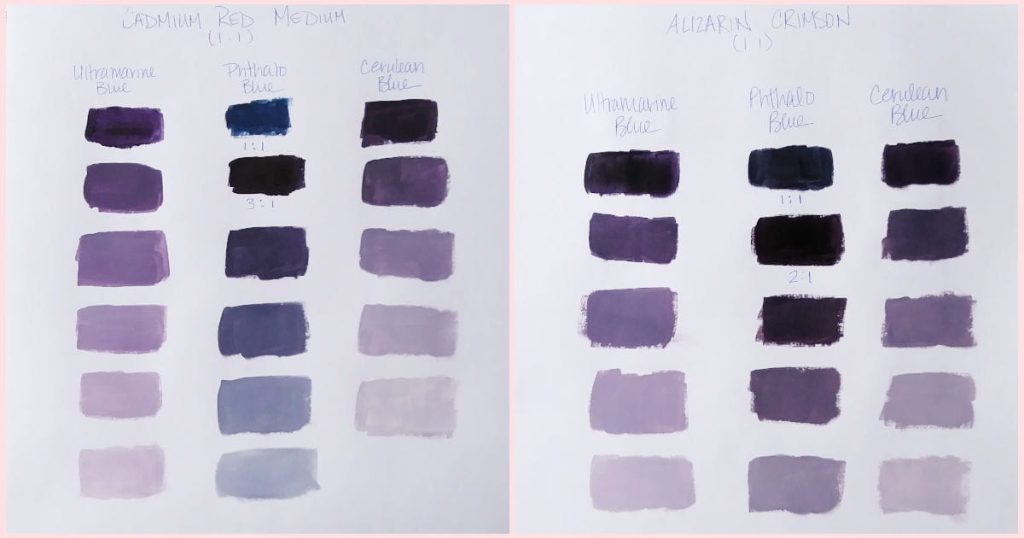
Recipes:
- One part Cad Red Medium to one part Ultramarine Blue
- Three parts Cad Red Medium to one part Phthalo Blue
- One part Cad Red Medium to one part Cerulean Blue
- One part Alizarin Crimson to one part Ultramarine Blue
- Two parts Alizarin Crimson to one part Phthalo Blue
- One part Alizarin Crimson to one part Cerulean Blue
In the photo above, you can see that there isn’t a lot of difference between using Cadmium Red Medium or Alizarin Crimson to make purple.
The one spot you’ll notice a bit of a change is when both reds are mixed with Phthalo Blue.
Phthalo Blue is a very strong pigment so I started by showing you what the mixture looked like as a one-to-one ratio and then start adding more parts of the two reds until a proper purple color was achieved.
In the Cadmium Red Medium experiment, I had to add three parts to one part Phthalo Blue.
On the other hand, I only had to add two parts Alizarin Crimson to one part Phthalo Blue. This tells us that Alizarin Crimson has more pigment load than Cadmium Red Medium.
That said, we have to take into consideration that the Cad Red Medium used in this experiment was a student grade whereas the Alizarin Crimson was a professional grade.
So, what did we learn through these two experiments? First, Phthalo Blue needs to be added slowly because it will easily overtake other pigments, and second, Cad Red Medium and Alizarin Crimson, although very different hues, end up creating purple paint very close in color.
How To Mute The Color Purple So It’s Less Vibrant
Our quest in learning how to make the color purple wouldn’t be complete without knowing how to make a muted purple. Muted purple is great for landscapes and anywhere you want to avoid too much flash.
So, how do you make a muted purple? You add yellow. Yellow is the complementary color to purple on the color wheel, meaning, it lies directly opposite on the wheel. Complementary colors really bring out the best in each other when they’re side-by-side but will dull each other down if mixed.
To learn more about complementary colors, check out my article which goes into a deeper explanation of how the color wheel works.
Paint Colors Used:
- Diox Purple (Liquitex Basics)
- Yellow Oxide (Liquitex Basics)
- Cadmium Yellow Medium (Liquitex Basics)
- Naples Yellow (Arteza Premium)
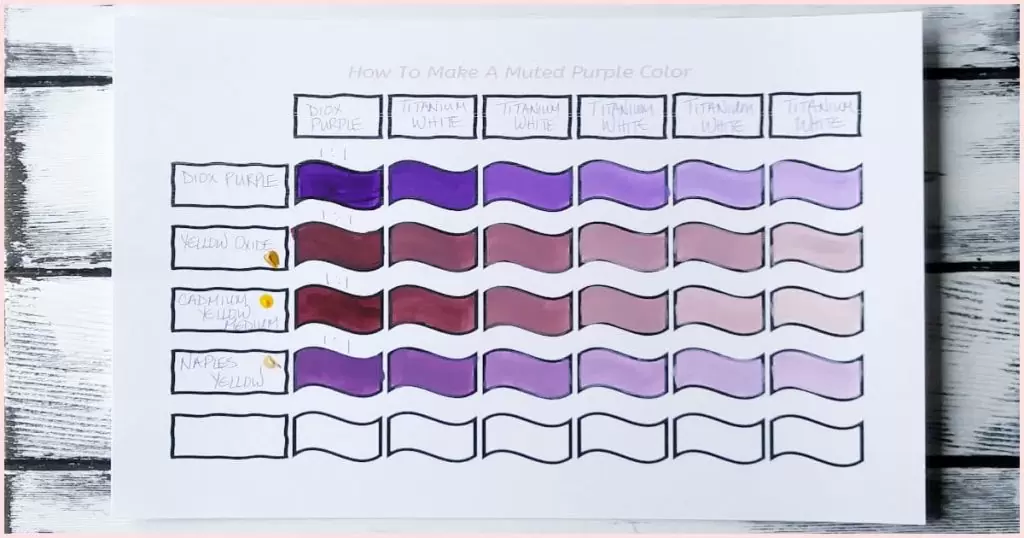
Recipes:
- One part Diox Purple to one part Yellow Oxide
- One part Diox Purple and one part Cad Yellow Medium
- One part Diox Purple to one part Naples Yellow
In this experiment, where we’re trying to make muted purple color, I mixed Diox Purple with Yellow Oxide, Cadmium Yellow Medium, and Naples Yellow.
The first column is the results of mixing the different yellow paint colors with Diox Purple (except the very first row, which is just Diox Purple mixed with Titanium White for a baseline). From there, I lightened each mixture with Titanium White.
I was pretty sure the yellows would be a little tricky to work with but what really surprised me was Naples Yellow.
Naples Yellow leans closer to yellow than Unbleached Titanium, which is a cream color, but just look at the purple it made!
Overall, I think we’ve learned that if you’re going to use Yellow Oxide or Cadmium Yellow Medium to make a muted purple color you should probably add the yellows in very slowly.
How To Make The Color Purple Lighter
What if we want to lighten purple paint? Obviously, Titanium White would definitely lighten any purple but there are other colors you can use that will, as well, but in different ways.
Paint Colors Used:
- Diox Purple (Liquitex Basics)
- Titanium White (Liquitex Basics)
- Zinc White (Golden Heavy Body)
- Unbleached Titanium (Liquitex Basics)
- Naples Yellow (Arteza Premium)
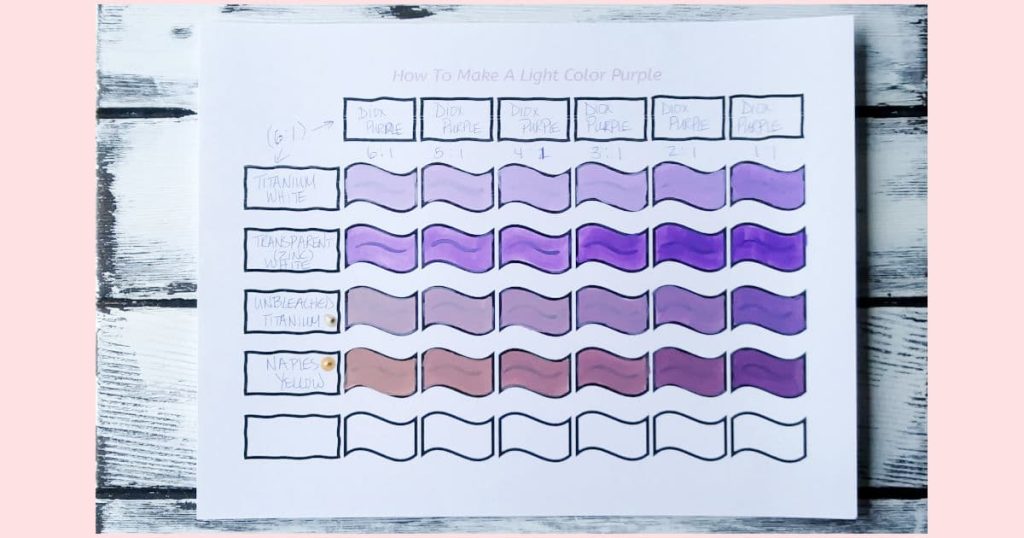
Paint Mixing Recipes:
- Six parts Titanium White and one part Diox Purple (adding one part less of Titanium White as we move to the right of the page)
- Six parts Zinc White to one part Diox Purple (adding one part less of Zinc White)
- Six parts Unbleached Titanium to one part Diox Purple (decreasing the Unbleached Titanium by one part moving from left to right)
- Six parts Naples Yellow to one part Diox Purple (decreasing the lightening color from left to right)
Okay, a lot is going on in the image above so, before we get into it, let me explain the columns and rows.
Each row represents a different paint color that I chose to lighten Diox Purple. Each column shows how the mixture behaves as it gradually becomes darker. In other words, I used the lightening paint color less and less the further to the right you go.
For this experiment, I added a black squiggle to each “box” because one of the colors used to lighten the purple is Zinc White (also known as Transparent White and Mixing White). I thought it would be interesting to see the different levels of transparency.
It’s no surprise that Unbleached Titanium and Naples Yellow need to be used sparingly. Both paint colors are on the warmer side and are within the realm of the complimentary color for purple, which is yellow.
How To Mix The Perfect Lavender Acrylic Paint Color
So how do we make a lavender color with purple paint? To make a lavender color you need to mix a light blue and a light pink, or light blue to an already made purple.
In this experiment, we’re going to try mixing Rose Azo with Cerulean Blue, and then we’ll lighten it with Titanium White. We’ll also try Magenta Light and Ultramarine Blue and again add some Titanium White for good measure.
Paint Colors Used:
- Rose Azo (Pebeo)
- Cerulean Blue (Liquitex Basics)
- Magenta Light (Arteza Premium)
- Ultramarine Blue (Liquitex Basics)
- Titanium White (Liquitex Basics)
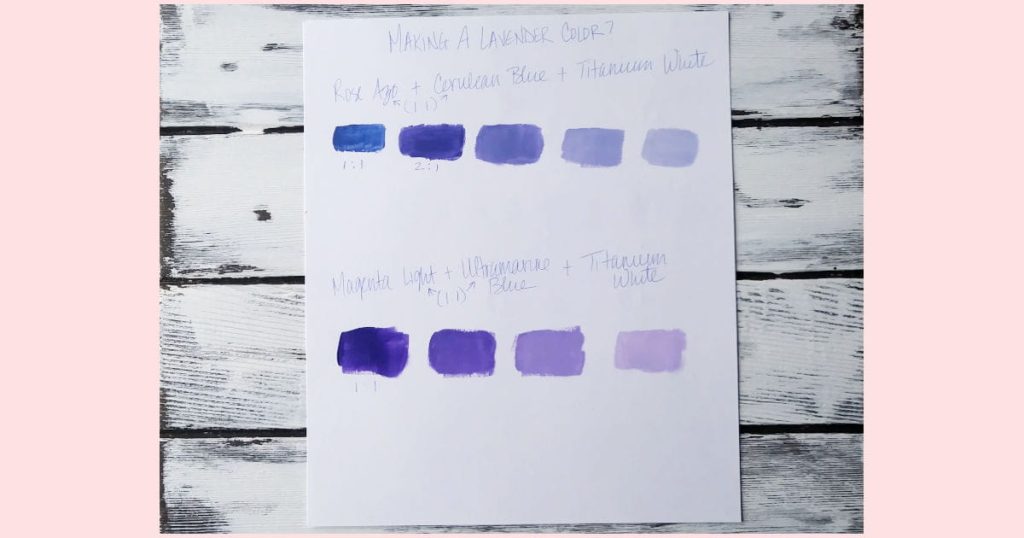
Acrylic Paint Recipes Created:
- Two parts Rose Azo to one part Cerulean Blue
- One part Magenta Light and one part Cerulean Blue
You’ll notice that I ended up mixing two parts Rose Azo into the Cerulean Blue because the one-to-one ratio created a really pretty blue color, which is lovely but not what we’re going for.
If you look closely you’ll notice the Magenta Light and Ultramarine Blue mixture is a bit on the warm side, meaning, it leans more towards red. For that reason, I wouldn’t consider this color lavender but it would certainly make a really nice lilac paint color.
In the end, the winner is the Rose Azo and Cerulean Blue combination.
Can You Make Purple Acrylic Paint Even Darker?
We’ve got quite a few purples happening but now let’s focus on how to make the color purple darker.
Let’s take a look at what happens when you mix Diox Purple with Burnt Umber, Mars Black, an Ultramarine Blue and Cadmium Orange mixture, and lastly, Phthalo Green and Cadmium Red Medium mixed together.
Paints Used in this Experiment:
- Diox Purple (Liquitex Basics)
- Burnt Umber (Liquitex Basics)
- Mars Black (Liquitex Basics)
- Ultramarine Blue (Liquitex Basics)
- Cadmium Orange (Liquitex Basics)
- Phthalo Green (Liquitex Basics)
- Cadmium Red Medium (Liquitex Basics)
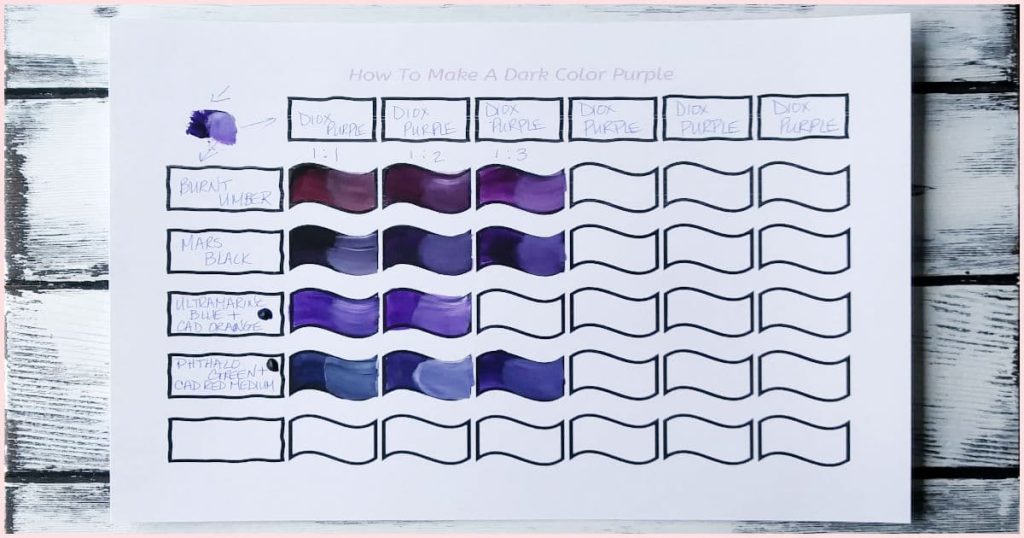
Paint Mixing Recipes:
- One part Diox Purple to one part Burnt Umber
- Two parts Diox Purple to one part Burnt Umber
- Three parts Diox Purple to one part Burnt Umber
- One part Diox Purple to one part Mars Black
- Two parts Diox Purple to one part Mars Black
- Three parts Diox Purple to one part Mars Black
- One part Diox Purple to one part Ultramarine Blue and Cad Orange Mix
- Two parts Diox Purple to one part Ultramarine Blue and Cad Orange Mix
- One part Diox Purple to one part Phthalo Green and Cad Red Medium Mix
- Two parts Diox Purple to one part Phthalo Green and Cad Red Medium Mix
- Three parts Diox Purple to one part Phthalo Green and Cad Red Medium Mix
Before we get into the nitty-gritty of the experiment findings, you should know that the mixture made with Phthalo Green and Cadmium Red Medium was mixed at a one-to-one ratio and the same goes for the Ultramarine Blue and Cadmium Orange mixture.
The purpose of this experiment was to start with a one-to-one ratio and then add more Diox Purple until the original mixtures roughly matched Diox Purple straight out of the tube.
To my eye, the Mars Black mixture and the mixture made with Ultramarine Blue and Cadmium Orange were the closest matches.
Mixing Up A Royal Purple Color
If you’ve been researching how to make royal purple with acrylic paint, boy, you’re going to get a lot of opinions.
It seems as though royal purple is one of those colors that everyone sees a little bit differently. That said, most people agree that it’s a very saturated cool color.
With that in mind, to make a royal purple paint you’d probably want to start by mixing a cool red and a cool blue together and then start adding in a bit more blue at a time to make it richer and deeper. Let’s take a closer look.
Paint Used In This Experiment:
- Ultramarine Blue (Liquitex Basics)
- Rose Madder (Arteza Premium)
- Quinacridone Magenta (Liquitex Basics)
- Titanium White (Liquitex Basics)
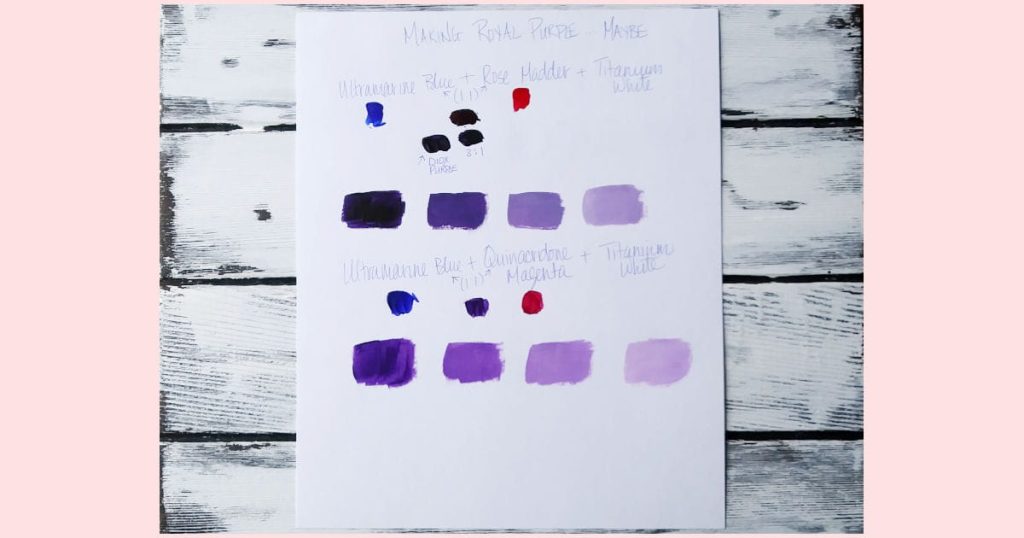
Paint Recipes Made:
- Three parts Ultramarine Blue to one part Rose Madder
- One part Ultramarine Blue and one part Quinacridone Magenta
To make a royal purple paint color I decided to try mixing Ultramarine Blue with Rose Madder and Quinacridone Magenta. I finished by lightening each mixture with Titanium White so you could better see how warm or cool each color was when comparing.
You’ll notice that it took three times as much Ultramarine Blue to Rose Madder to make the purple color I ended up with. Although the mixture at a one-to-one ratio was gorgeous, it leaned too much toward red.
Really, this is a tough one because both mixtures could be considered royal purple depending on what other colors you plan to use in your painting. The warmer the other colors in your painting are, the cooler both mixtures will look.
My personal favorite would have to be the Ultramarine Blue and Quinacridone Magenta mixture. It creates a nice vibrancy while still having that rich look to it.
How To Make An Icy Cool Purple Color
A cool shade of purple is great to use in landscape paintings where you want to give the shadows a frigid feeling. I like to use it for shadows in drifting snow or snow hanging off tree limbs.
Making a purple cooler should be pretty simple, right? Let’s try adding Ultramarine Blue and Cobalt Blue to Diox Purple and see what happens.
Acrylic Paint Used:
- Diox Purple (Liquitex Basics)
- Ultramarine Blue (Liquitex Basics)
- Cobalt Blue (Liquitex Basics)
- Titanium White (Liquitex Basics)
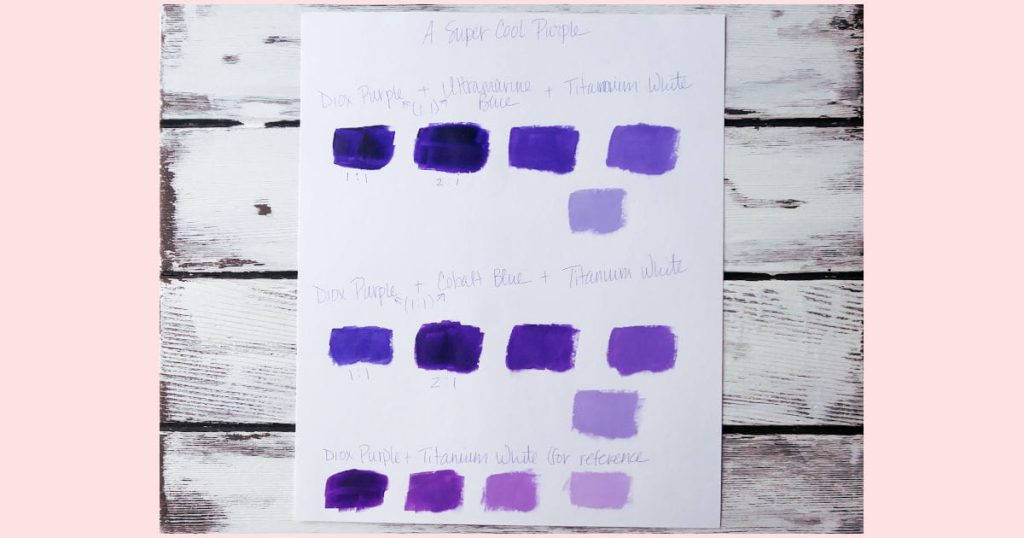
Paint Color Recipes:
- Two parts Diox Purple to one part Ultramarine Blue
- Two parts Diox Purple to one part Cobalt Blue
For reference, I mixed Diox Purple with Titanium White along the bottom row. Comparing it with the two purple mixtures above, it’s pretty easy to see that blue added to Diox Purple will definitely make the color cooler.
Both ultramarine blue and cobalt blue will make a gorgeous cool purple color. Just keep in mind that both blues are quite pigmented and will overtake Diox Purple. Add it slowly and go from there.
If you don’t have the same colors that I used for the experiment, don’t worry. Just make sure that the blue and red you use have cool undertones. So, look for icy blues and avoid tomato/fire red. A red that leans more toward purple/magenta will give you the best result.
The other way to make sure that your purple is cooler is to mix your red and blue in equal parts and then start slowly adding in more blue until you get the coolness you’re looking for.
Making A Warm Color Purple
Warm purples are great when you are painting certain flowers, such as lilacs, and also used in shadows where you want to make sure you don’t lose any warmth in your painting. I like using warm purple to create shape and dimension to rocks and mountains.
Warm purple could be called things like wine or Bordeaux, etc. It’s that interesting in-between color that’s not quite red but not quite purple
One way you can accomplish a warm purple color is to add red to purple. So, let’s see what happens when we mix Diox Purple with Cadmium Red Medium.
Colors Used In This Experiment:
- Diox Purple (Liquitex Basics)
- Cadmium Red Medium (Liquitex Basics)
- Titanium White (Liquitex Basics)

Paint Recipes:
- One part Diox Purple to one part Cadmium Red Medium Hue
- The above mixture lightened with Titanium White
For this experiment, I mixed Diox Purple with Cadmium Red Medium at a one-to-one mixture and then lightened it with Titanium White. This made a gorgeous warm purple that would be perfect for painting lilacs.
Another way to make purple warmer is to use the warmest blue and red in your acrylic paint collection. Also, you can just add more red than blue if you’re making your own purple from scratch.
Bonus Warm Purple Recipes:
- One part Burnt Umber plus one part Quinacridone Magenta
- One part Raw Umber and one part Quinacridone Magenta
- One part Light Green Permanent plus two parts Quinacridone Magenta
- One part Hooker’s Green and two parts Quinacridone Magenta
- One part Diox Purple and one part Cadmium Red Deep
- One part Diox Purple plus one part Alizarin Crimson
- One part Ultramarine Blue plus one part Cadmium Red Medium
- One part Cobalt Blue plus one part Cadmium Red Medium
- One part Cobalt Blue and one part Cadmium Red Deep
How To Make The Color Purple Using…Brown???
Okay, so now we’re really going to think outside the box. Let’s look at how to make the color purple with some earthy colors, in particular Burnt Umber and Burnt Sienna. We’ll mix those two paint colors with Ultramarin Blue, and then, we’ll take those mixtures and add some alizarin crimson to them. Seems like a pretty unlikely way to make the color purple, right? Let’s find out!
Earthy Brown Mixture #1
First, let’s take a look at what happens when you mix Ultramarine Blue and Burnt Sienna. Then, we’ll take whatever mixture that makes and add Alizarin Crimson.
Paint Colors Used:
- Ultramarine Blue (Liquitex Basics)
- Burnt Sienna (Golden Heavy Body)
- Alizarin Crimson (Liquitex Professional Heavy Body)
- Titanium White (Liquitex Basics)
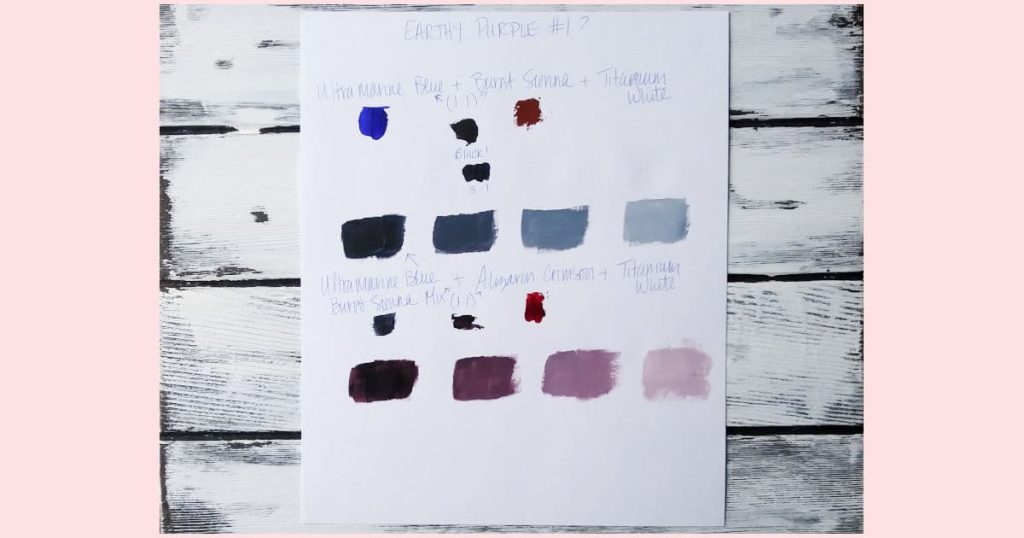
Paint Combos Created:
- Three parts Ultramarine Blue to one part Burnt Sienna
- One part Ultramarine Blue/Burnt Sienna Mix to one part Alizarin Crimson
In the image above I started by mixing one part Ultramarine Blue and one part Burnt Sienna, which created black! So, I took the black mixture and added more Ultramarine Blue to it just to see what would happen. Lastly, I added Alizarin Crimson to the final Ultramarine Blue and Burnt Sienna recipe, in equal parts, to come up with an earthy color purple.
It’s not really surprising that the purple color ended up being quite warm and slightly muted. And, although it’s not a vibrant color, it’s definitely very rich looking.
Earthy Brown Combination #2
Now, what about when we mix Ultramarine Blue with Burnt Umber? And what happens when we take that mixture and add Alizarin Crimson?
Acrylic Paint Used:
- Ultramarine Blue (Liquitex Basics)
- Burnt Umber (Liquitex Basics)
- Alizarin Crimson (Liquitex Professional Heavy Body)
- Titanium White (Liquitex Basics)

Color Mixing Recipes:
- One part Ultramarine Blue to one part Burnt Umber
- One part Ultramarine Blue/Burnt Umber mixture to one part Alizarin Crimson
For our second experiment, in our quest to make an earthy purple, I started by mixing Ultramarine Blue and Burnt Umber at a one-to-one ratio. Again, this made a black and, in fact, this is my favorite recipe to use when I paint black fur for pet portraits.
This time I decided to leave the black mixture as is and not add any additional Ultramarine Blue. I wanted to see if a deep black could be made into purple without the help of extra blue.
Again, I finished by adding one part of Alizarin Crimson to the black mixture. This also created a muted warm purple but it’s a bit dusty looking, for lack of a better term. I’m pretty sure it has that muted dusty look because no additional blue was added.
Even More Acrylic Paint Recipes For Making The Color Purple!
If you’ve been with me for a while, you know that I do a lot of color experimenting so it shouldn’t be any surprise I’ve accidentally come across some interesting paint mixes that make the color purple.
Below, you’ll find a bonus list of color recipes for how to make the color purple. If these colors were made during one of my other color experiments, I’ll leave a link so you can check it out. Otherwise, the recipes are my own that I’ve discovered throughout my art journey (see? Keeping a paint color recipe book comes in handy!)
The first purple color in the list actually comes from a color study I did for a painting that I created especially for my mom.
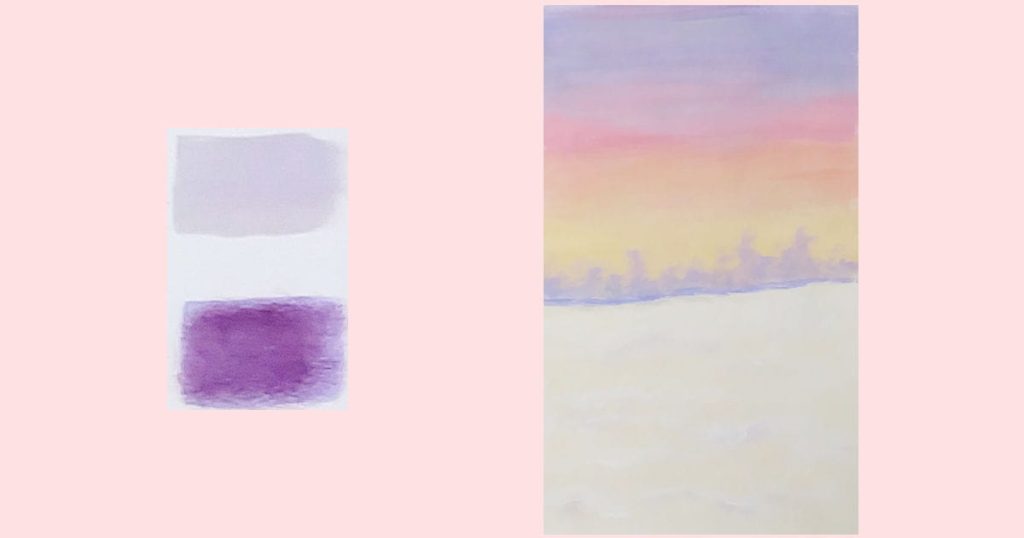
Sometimes when I’m not sure which paint colors I want to use I’ll do a color study. In a color study, I’ll try different recipes to see if the colors I’m thinking of using will actually work and I keep track of each recipe so it’s easy to mix up when I get down to business.
Paint Colors Included In Bonus Recipes:
- Quinacridone Magenta (Liquitex Basics)
- Ultramarine Blue (Liquitex Basics)
- Titanium White (Liquitex Basics)
- Cadmium Red Deep (Liquitex Basics)
- Cerulean Blue (Liquitex Basics)
- Primary Blue (Liquitex Basics)
- Cobalt Blue (Liquitex Basics)
- Phthalo Blue (Liquitex Basics)
- Phthalo Green (Liquitex Basics)
- Rose Madder (Arteza Premium)
- Cadmium Red Medium (Liquitex Basics)
- Violet (Arteza Premium)
- Light Sap Green (Arteza Premium)
- Chromium Oxide Green (Arteza Premium)
- Diox Purple (Liquitex Basics)
Big List of Bonus Paint Mixing Recipes:
- One part Quinacridone Magenta + one part Ultramarine Blue + Titanium White to desired paleness
- One part Cadmium Red Deep + one part Ultramarine Blue
- One part Cadmium Red Deep + one part Cerulean Blue
- One part Cadmium Red Deep + one part Primary Blue
- One part Cadmium Red Deep + one part Cobalt Blue
- One part Cadmium Red Deep + one part Phthalo Blue (Making Magenta)
- One part Phthalo Green + one part Quinacridone Magenta (Making Magenta)
- One part Phthalo Blue + one part Rose Madder + Titanium White (Making Magenta)
- One part Cadmium Red Medium + one part Phthalo Blue + Titanium White (Making Magenta Paint)
- Two parts Violet + one part Light Sap Green (Mixing Purple and Green)
- Two parts Violet + one part Chromium Oxide Green (Purple and Green Paint Mix)
- Two parts Diox Purple + one part Light Sap Green (Purple and Green Recipes)
- Two parts Diox Purple + one part Chromium Oxide Green (Purple and Green)
The articles where you’ll find the original experiments that led to some of the above purple color recipes are:
I know I’ve mentioned adding Ultramarine Blue to Quinacridone Magenta at a one-to-one ratio but just that combination alone makes so many more colors!
In the image below I start with my base recipe and as you move down the column, I gradually added more Titanium White each time.
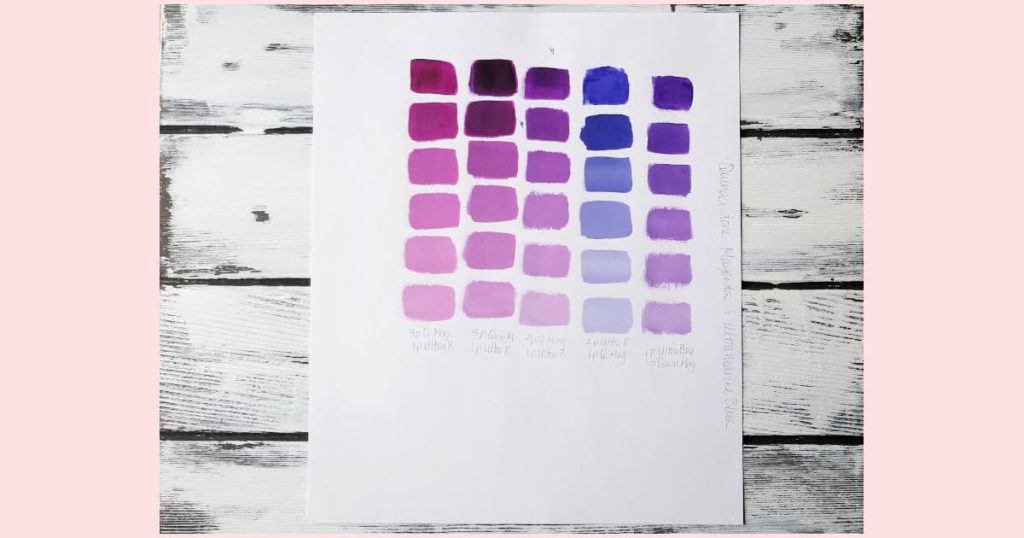
Color Recipes by Column:
- Four parts Quinacridone Magenta and one part Ultramarine Blue
- Three parts Quinacridone Magenta and one part Ultramarine Blue
- Two parts Quinacridone Magenta to one part Ultramarine Blue
- Two parts Ultramarine Blue to one part Quinacridone Magenta
- One part Quinacridone Magenta and one part Ultramarine Blue
How To Use Purple In Your Artwork
Surprisingly, I use purple a lot in my artwork so I feel that it’s a must-have color whether you buy a tube or mix up your own recipes.
Here are some ways you can use purple in your own artwork:
- Snow
- Mountains
- Stormy skies
- Sunrises
- Sunsets
- Flowers
- Shadows
- Clouds
- Pop of unexpected color
- Silhouette color for distant trees and land masses
If you’re excited to start using your new purple colors, I’ve found the perfect YouTube tutorial for ya!
Joni Young Art has this wonderful impressionistic lilac flower tutorial that’s really loose and simple. If you do decide to try it, think of it as playing with your new paint and don’t get too precious about it. Just have fun!
Final Thoughts On Experimenting With Making Purple Paint
And so ends another paint color experiment, this time learning how to make the color purple.
With all of the recipes I’ve shared, along with the information I’ve given you, you should have no trouble finding just the right purple color for your next acrylic painting.
And, if you haven’t found one that you like in this article, start playing with your own paints and keep track of what recipes you can come up with. You never know when those recipes will come in handy.
More Articles Related To Color Mixing:
- Learn to Make Hot Pink Paint
- Mixing Up Navy Blue Paint
- Making Turquoise Paint
- How To Choose Your Paint Colors From An Image

Meet Sara, a seasoned veteran in the world of art. With a knack for mixing paints to unveil breathtaking new hues, she’s adorned countless commissions and independently captivated art enthusiasts with her creations. Having spent over a decade immersed in the realm of art gallery management, Sara’s insight into the intricacies of the art scene shines through her work.
But don’t let her impressive résumé fool you – Sara’s approach to art is as lively as her palette. Known for her wit and humor, she infuses her passion for painting with a playful spirit, making every stroke a delightful adventure. As a dedicated mentor, she’s committed to guiding her fellow artists towards success, always staying ahead of the curve with the latest techniques and trends.
